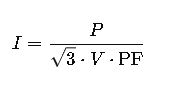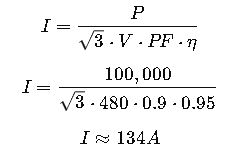Correct cable sizing in three-phase systems ensures safety, efficiency, compliance with NEC standards, and long-term reliability.
Proper conductor selection minimizes voltage drop, prevents overheating, reduces energy losses, and guarantees electrical equipment operates effectively.
Three-Phase Cable Sizing Calculator (NEC)
Compute minimum wire size by ampacity (NEC 310.16) and check voltage drop.
Load & System
Installation & Conductor
Distance & Voltage Drop
What does the calculator do?
Three-phase current formula
Temperature & bundling factors
Voltage drop
Disclaimer
Importance of Cable Sizing in Three-Phase Systems
- Safety compliance: Prevents conductor overheating and reduces fire risk.
- Voltage stability: Maintains voltage within permissible limits to protect loads.
- Efficiency: Reduces I²R losses and improves energy efficiency.
- Equipment protection: Ensures motors, transformers, and sensitive devices receive correct voltage/current.
- Code compliance: NEC requires that conductor ampacity, voltage drop, and environmental conditions be considered.
Key NEC References for Cable Sizing
The following NEC articles are fundamental when performing three-phase cable sizing:
- NEC Article 310.15 – Ampacity tables for conductors.
- NEC Article 210.19(A)(1) – Voltage drop recommendations.
- NEC Article 240 – Overcurrent protection coordination with conductors.
- NEC Article 110.14(C) – Termination temperature limitations.
- NEC Annex D Examples – Practical cable sizing methods.
Authoritative reference: NFPA NEC Standards.
Fundamental Formulas for Three-Phase Cable Sizing
The three-phase current and voltage drop are the basis of conductor selection.
1. Three-Phase Current Formula
Where:
- I = Line current (A)
- P = Total power (W)
- V = Line-to-line voltage (V)
- PF = Power factor (0–1, typically 0.8–1.0 for industrial loads)
Common values:
- Industrial PF ≈ 0.85–0.95
- Voltage (V): 208V, 400V, 480V, 600V are typical in NEC practice
2. Voltage Drop Formula (Three-Phase)
Where:
- VD% = Voltage drop percentage
- I = Load current (A)
- L = Length of conductor run (m or ft)
- R = Resistance per unit length of conductor (Ω/m or Ω/ft)
- V = System voltage (V)
NEC recommends:
- ≤ 3% voltage drop for feeders or branch circuits.
- ≤ 5% total (feeder + branch combined).
3. Ampacity Selection Formula
Where:
- Icable = Corrected ampacity of the conductor
- Iload = Load current (A)
- Kadj = Adjustment factor for number of conductors in raceway (from NEC Table 310.15(C)(1))
- Ktemp = Temperature correction factor (from NEC Table 310.15(B)(2)(a))
Common Reference Tables for Three-Phase Cable Sizing (NEC)
Below is a practical table with typical ampacity values for copper conductors with THHN insulation (90°C rating), based on NEC 310.16, assuming 30°C ambient temperature and up to three current-carrying conductors.
Table 1. NEC Copper Conductor Ampacity (THHN, 90°C, ≤3 conductors, 30°C ambient)
| AWG / kcmil | Ampacity (A) | Typical Applications |
|---|---|---|
| 14 AWG | 25 A | Small branch circuits |
| 12 AWG | 30 A | Lighting, small motors |
| 10 AWG | 40 A | HVAC, water heaters |
| 8 AWG | 55 A | Small feeders, large appliances |
| 6 AWG | 75 A | Residential feeders |
| 4 AWG | 95 A | 3-phase motors, small commercial |
| 3 AWG | 110 A | Feeders for 100A panels |
| 2 AWG | 130 A | Small industrial feeders |
| 1 AWG | 150 A | Motors, panels 150A |
| 1/0 AWG | 170 A | Large HVAC, feeder |
| 2/0 AWG | 195 A | Small commercial mains |
| 3/0 AWG | 225 A | Industrial feeders |
| 4/0 AWG | 260 A | Large commercial mains |
| 250 kcmil | 290 A | Industrial distribution |
| 300 kcmil | 320 A | Large feeders |
| 350 kcmil | 350 A | Motors >250 HP |
| 400 kcmil | 380 A | Industrial feeders |
| 500 kcmil | 430 A | Large distribution feeders |
| 600 kcmil | 475 A | High load feeders |
| 750 kcmil | 535 A | Service conductors |
| 1000 kcmil | 615 A | Large utility feeders |
Table 2. Aluminum Conductor Ampacity (XHHW-2, 90°C, ≤3 conductors, 30°C ambient)
| AWG / kcmil | Ampacity (A) | Typical Applications |
|---|---|---|
| 12 AWG | 25 A | Lighting, receptacles |
| 10 AWG | 35 A | Small branch circuits |
| 8 AWG | 45 A | Appliances |
| 6 AWG | 65 A | Feeders |
| 4 AWG | 85 A | Motors, panels |
| 2 AWG | 115 A | Small feeders |
| 1/0 AWG | 150 A | Main feeders |
| 4/0 AWG | 205 A | Service conductors |
| 350 kcmil | 310 A | Industrial feeders |
| 500 kcmil | 380 A | High-load feeders |
| 750 kcmil | 475 A | Distribution feeders |
| 1000 kcmil | 545 A | Utility services |
Voltage Drop Reference Values (Copper Conductors, 75°C)
| Conductor Size | Resistance (Ω/1000ft) | Reactance (Ω/1000ft) |
|---|---|---|
| 14 AWG | 2.525 | 0.083 |
| 12 AWG | 1.588 | 0.078 |
| 10 AWG | 0.999 | 0.075 |
| 8 AWG | 0.628 | 0.071 |
| 6 AWG | 0.395 | 0.068 |
| 4 AWG | 0.248 | 0.066 |
| 2 AWG | 0.156 | 0.063 |
| 1/0 AWG | 0.098 | 0.061 |
| 4/0 AWG | 0.049 | 0.058 |
| 350 kcmil | 0.028 | 0.057 |
| 500 kcmil | 0.021 | 0.056 |
| 750 kcmil | 0.014 | 0.055 |
| 1000 kcmil | 0.011 | 0.054 |
These resistance values are used in voltage drop calculations for long feeder runs.
Ampacity Correction and Adjustment Factors (NEC Requirements)
In real installations, the ampacity values from NEC Tables 310.16 cannot always be used directly. The NEC requires applying correction factors for ambient temperature and adjustment factors for conductor bundling (more than three current-carrying conductors in a raceway or cable).
1. Temperature Correction Factors (NEC Table 310.15(B)(2)(a))
For conductors with 90°C insulation rating (THHN, XHHW-2, etc.), and 30°C ambient base, apply correction factors:
| Ambient Temp (°C) | Factor (90°C rated insulation) |
|---|---|
| 21–25 °C | 1.08 |
| 26–30 °C | 1.00 |
| 31–35 °C | 0.91 |
| 36–40 °C | 0.82 |
| 41–45 °C | 0.71 |
| 46–50 °C | 0.58 |
| 51–55 °C | 0.41 |
| 56–60 °C | 0.29 |
Example: A THHN conductor in an area with 40°C ambient must be derated to 82% of its table ampacity.
2. Adjustment Factors for More Than Three Conductors (NEC Table 310.15(C)(1))
When more than three current-carrying conductors are installed in the same raceway, cable, or bundled, apply these adjustment factors:
| Number of Conductors | Factor |
|---|---|
| 4–6 | 0.80 |
| 7–9 | 0.70 |
| 10–20 | 0.50 |
| 21–30 | 0.45 |
| 31–40 | 0.40 |
| 41 and above | 0.35 |
3. Combined Effect
The effective ampacity is calculated as:
Where:
- Iampacity = base ampacity from NEC Table 310.16
- Ktemp = temperature correction factor
- Kadj = adjustment factor for conductor count
Real-World Example 1: Sizing a Feeder for a 100 kW Motor Load (480V, Three-Phase)
Problem Statement:
A 100 kW induction motor at 480V three-phase (PF = 0.9, Efficiency = 95%) must be fed by a copper cable, run length 100 ft. Ambient temperature is 40°C, and the conduit contains 6 current-carrying conductors. Determine the correct conductor size according to NEC, considering voltage drop and derating.
Step 1: Calculate Load Current
Step 2: Select Base Ampacity
From NEC Table 310.16 (90°C, Copper THHN):
- 3/0 AWG = 225 A
- 2 AWG = 130 A
So, 2 AWG is too small. Try 3/0 AWG with 225 A base ampacity.
Step 3: Apply Derating Factors
- Temperature (40°C) → Ktemp = 0.82
- 6 conductors → Kadj = 0.80
Since 148 A ≥ 134 A load, 3/0 AWG copper is acceptable.
Step 4: Check Voltage Drop
Voltage drop formula (resistive only for simplicity):
For 3/0 AWG copper, R = 0.049 Ω/1000ft.
- L = 100 ft → 0.0049 Ω total.
This is well within the NEC recommendation (≤3%).
Final Answer: Use 3/0 AWG copper THHN for this 100 kW, 480V motor feeder.
Real-World Example 2: Long Feeder for a 200A Panel (208V, Three-Phase)
Problem Statement:
A 200A distribution panel at 208V three-phase is located 250 ft away from the main switchboard. Copper conductors are used, with THHN insulation, in a conduit containing 9 current-carrying conductors, ambient temperature 35°C. Determine the correct cable size considering NEC derating and voltage drop.
Step 1: Load Current
The panel is rated at 200A continuous.
Step 2: Base Ampacity Selection
From NEC Table 310.16:
- 4/0 AWG copper = 260 A
Step 3: Apply Derating
- Temperature (35°C) → Ktemp = 0.91
- 9 conductors → Kadj = 0.70
Not sufficient (needs ≥200A). Increase size.
Try 350 kcmil copper (310 A base):
Still below 200 A.
Try 400 kcmil copper (380 A base):
This satisfies ampacity requirement.
Step 4: Voltage Drop Calculation
Resistance for 400 kcmil copper = 0.029 Ω/1000ft.
For 250 ft one-way:
Voltage drop:
Well within NEC recommendation.
Final Answer: Use 400 kcmil copper THHN for the 200A feeder, 208V, 250 ft run.
Frequently Asked Questions (FAQ) about Three-Phase System Cable Sizing – NEC
1. How do you calculate current in a three-phase system?
You need to know three things: the total power of the load, the system voltage, and the power factor. With these values, engineers use standard methods from the NEC to determine the current that flows in each conductor.
2. What is the maximum allowable voltage drop according to NEC?
The NEC recommends that voltage drop should not exceed 3% on a single feeder or branch circuit, and 5% total when considering both feeder and branch circuits together. This ensures good performance and protects electrical equipment.
3. What is the difference between copper and aluminum conductors?
- Copper conductors are more efficient, stronger, and require smaller sizes for the same current, but they are more expensive.
- Aluminum conductors are lighter and more affordable, but they require larger sizes to carry the same current and need special attention at terminations.
4. How do ambient temperature and conduit fill affect cable sizing?
If the cables are installed in hot environments or when many conductors are grouped in the same conduit, their capacity to carry current decreases. The NEC requires applying correction factors in these cases, often leading to the selection of larger conductor sizes.
5. Can I use 90°C rated conductors at their full ampacity?
Not always. Even though the cable insulation may be rated for 90°C, the electrical equipment (such as circuit breakers, lugs, and panels) may only allow 60°C or 75°C terminations. The NEC requires following the lower temperature rating of the equipment, not just the wire.
6. What are the most common voltages in three-phase systems under NEC?
In the United States, the most common three-phase voltages are 208V, 240V, 480V, and 600V. Industrial and commercial facilities frequently use 480V, while 208V is common in commercial buildings.
7. When should aluminum be preferred over copper?
Aluminum is generally preferred in large feeders and service conductors where cost savings and lighter weight are important. Copper is preferred in shorter runs, high-reliability applications, or where space is limited.













